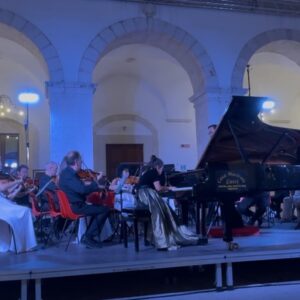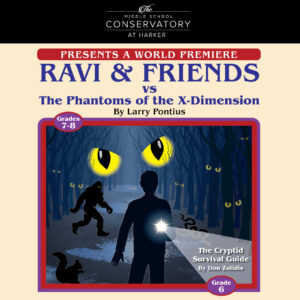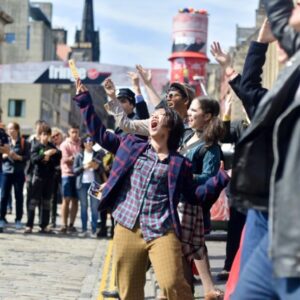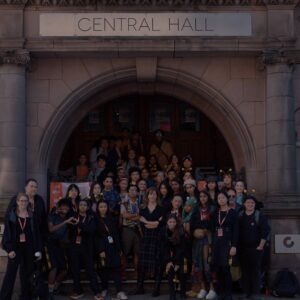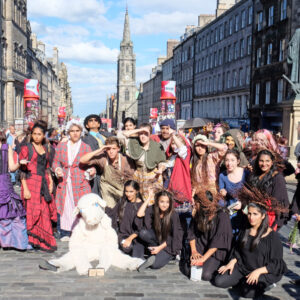The Harker Conservatory completed its second appearance at the largest arts festival in the world, the Edinburgh Festival Fringe, with a successful run of “Pippin” in August.
In 1947, eight uninvited theatrical groups descended on the newly formed Edinburgh International Festival, performing “on the fringes.” The trend caught on, and in 1959 the Fringe became official. In 1994, the American High School Theatre Festival (AHSTF) formed and instituted a competition to choose and facilitate the appearance of high-caliber secondary school drama departments at this mecca of arts festivals.
The Harker Conservatory was first nominated for the Fringe by the now-defunct American Musical Theater of San Jose back in 2006. After an in-depth application process and review of years of The Harker School shows, Harker was selected from more than 300 applicants as one of 38 schools to appear under the AHSTF banner, and “Urinetown: The Musical” performed to impressive crowds in 2007.
Laura Lang-Ree, chair of the performing arts department K-12, has set a goal of attending the Fringe once every four years, and in 2010 Harker was one of 45 schools accepted. Choosing just the right show is a challenge, Lang-Ree says: “It’s about finding the right mix of sophistication and edginess. The Fringe is not the place to bring something that is the equivalent of vanilla yogurt. It’s got to zing, it’s got to grab the attention of thousands of potential audience members and it’s got to be memorable.”
Preparing for the Fringe takes a full year, not the least of which is trimming the show to fit into a strict 90-minute format. The set must accompany the actors as well, putting additional demands on Paul Vallerga, Harker’s innovative set designer.
When the reworking was complete, the set, costumes and props were divided up among the cast’s luggage, and the troupe arrived in London for some sight-seeing, a workshop at the reconstructed Globe Theatre and a performance of “Billy Elliott” in London’s West End theater district.
After two days in London, the cast boarded what they fondly dubbed “The Hogwarts Express,” the train from King’s Cross Station to Edinburgh – known to this generation for being the station at which Harry Potter and friends board the train to their school. An AHSTF guide met the train and escorted the cast out of the station in a slow march behind a bagpiper, giving an air of formality to the occasion and creating quite a stir among the other passengers.
Once settled in their dorm rooms on the campus of the University of Edinburgh, the cast’s adventure began in earnest. A packed schedule of rehearsals, publicity, shows and shopping ensued. Fundraising efforts during the school year meant that Lang-Ree was able to arrange for several group meals together as well as attendance at 12 professional shows of varying genres.
One highlight was the relationship Harker developed with an American improv troupe called “Baby Wants Candy.” They create an hour-long musical based on a title suggested by an audience member, and the “Pippin” cast met them during publicity times and promised to attend each other’s shows. The BWC troupe gave a shout out from the stage to the Harker group at their performance, and were gracious enough to arrange a special workshop at the dorms for Harker and another California high school.
AHSTF arranged for a day’s outing to Stirling Castle via a beautiful coach ride through the Trossachs, Scotland’s lower highlands; they also gave students tickets to the Edinburgh Military Tattoo, an extravagant celebration of the U.K.’s many regiments from around the world; and arranged for them to go to a ceilidh, where all the AHSTF students learned traditional Scottish dancing.
But of course the highlight of the trip was performing “Pippin” at the beautiful Church Hill Theatre. Participating AHSTF schools support each other by attending at least four other high school shows, so the challenge for each school is to fill the theater’s seats with “regular” Festival-goers in addition to the high school students.
In addition to the show, each school is allotted one 20-minute slot on a small stage on Edinburgh’s main street, The Royal Mile. “Pippin” cast members braved the rain in full costume and gathered a huge crowd with their opening number, after which they took to the Mile with a three-card Monty game whose trick card was printed with all the “Pippin” information. The cast was able to “trick” locals, foreigners, other performers and, in one notable occasion, two local police officers into choosing the info card, and the hard work paid off with approximately 240 people attending one of the four performances of “Pippin,” including many of the other high schools who weren’t required to attend but who had heard the buzz.
The demands of mounting a Fringe show led to the cast reaching deep within themselves for stamina, flexibility, humor and grace under pressure, and they all rose to the occasion beautifully. The final performance had 125 people in the audience (Fringe shows average seven people), and Lang-Ree was surrounded by other American directors asking, “How did you do this?” Lang-Ree recalled, “This moment was a professional highlight for me; such a huge compliment to the cast and crew and an even bigger compliment to the entire performing arts department at Harker as our kids really are a reflection of their K through Life experience.”
An online arts group reviewed the show, giving it four stars and writing, “An excellent production of Pippin by an enthusiastic and well-drilled cast.” The final accolade came from the head of AHSTF, who asked the Harker cast to provide the only performance at their closing ceremonies. One final time, the stalwart cast donned makeup and costumes and wowed the 800 people in attendance.
Lang-Ree mused, “We were selected by AHSTF as one of the best and brightest musical theater programs in America, so I think it’s very important that what we bring to the Fringe – artistically, technically, creatively – be a home run. This event is not a ‘dress rehearsal’ for theater life – the Fringe is the real deal.”


